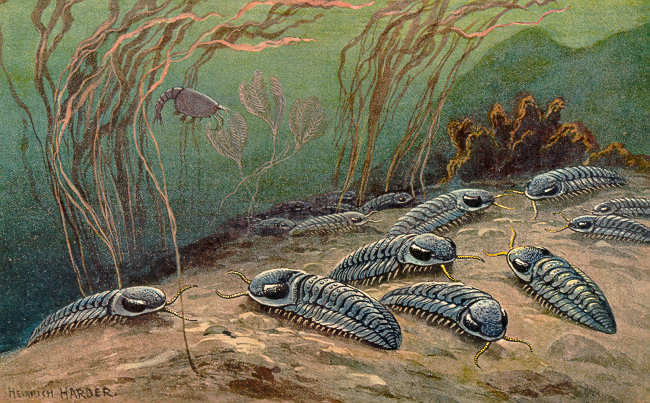Trilobite, Scavenger of the Primeval Deep
This Armored Trilobite Scuttles Through Ancient Seas Like a Living Tank With Alien Eyes!
Trilobite is a small, segmented arthropod that scuttles along the seafloor with methodical precision. Its body is divided into three distinct lobes—one central and two lateral—and three regions: a rounded cephalon (head), a ribbed thorax of articulated plates, and a compact pygidium (tail). Its dorsal exoskeleton is tough, often ornamented with ridges or spines, and capable of enrollment, allowing it to curl into a protective ball when threatened. Many species sport a pair of compound eyes, with some exhibiting crystalline lenses that grant surprisingly advanced vision for their time.
Trilobites behave as bottom-dwelling foragers or scavengers, navigating the seabed in search of microbial mats, decaying organic matter, or detritus. Some species dig shallow burrows, while others creep across sediment, leaving tiny trackways that fossilize behind them. Though slow-moving and defenseless against larger predators like Anomalocaris, their hard exoskeleton and ability to roll up serve as their primary defenses.
They inhabit shallow marine environments—warm, sunlit seafloors, reefs, or deeper benthic zones—where nutrients accumulate and biodiversity flourishes. The trilobite thrives in these ancient ecosystems, often forming dense populations on the ocean bottom.
Its modus operandi is simple: move, sense, and feed. It uses antennae and eye structures to detect subtle vibrations and chemical cues in the water or substrate. Some species are nocturnal grazers, emerging when the seafloor is quietest.
The Trilobite’s motivation is survival through persistence and adaptability. Not a hunter or a ruler, it is an enduring pioneer—exploiting niches, resisting extinction pressures for hundreds of millions of years, and outlasting countless other lineages through sheer evolutionary resilience.
Trilobite 5e
Swarm of Trilobites 5e
Trilobite, Pathfinder
Trilobite
Tiny Beast, Unaligned
Challenge: 1/8 (25 XP)
Proficiency Bonus: +2
Armor Class 15 (natural armor)
Hit Points 10 (3d4 + 3)
Speed 20 ft., swim 10 ft., burrow 5 ft.
| STR | DEX | CON | INT | WIS | CHA |
|---|---|---|---|---|---|
| 4 (–3) | 14 (+2) | 13 (+1) | 1 (–5) | 12 (+1) | 2 (–4) |
Saving Throws
Dex +4
Skills
Stealth +6, Perception +3
Damage Resistances
Slashing (nonmagical)
Senses
Darkvision 30 ft., Tremorsense 10 ft., Passive Perception 13
Languages —
Traits
Armored Exoskeleton
The trilobite’s segmented shell grants it resistance to slashing damage from nonmagical attacks.
Compound Vision
The trilobite has advantage on Wisdom (Perception) checks that rely on sight. It can’t be blinded by the invisible condition.
Amphibious
The trilobite can breathe both air and water.
Actions
Scuttle
Attack (Melee Weapon): +4 to hit, reach 5 ft., one target.
Hit: 3 (1d4 + 1) piercing damage.
Swarming Rush (Recharge 5–6)
If two or more trilobites are adjacent to the same target, each of them can make a Scuttle attack with advantage as part of this action. If three or more attacks hit the same target, that creature must succeed on a DC 11 Constitution saving throw or have disadvantage on the next attack roll or ability check it makes before the end of its next turn.
Reactions
Enroll (1/Short Rest)
When the trilobite is hit by an attack, it can curl into a tight defensive shape. Until the start of its next turn, it gains +2 to its AC and advantage on saving throws against being grappled or restrained.
Tactics
Trilobites operate defensively and rely on their stealth, natural armor, and numbers. They ambush lone prey or scurry away when outmatched. They’re ideal as creeping environmental threats or swarming minions to distract and harass adventurers in ancient seafloor ruins or time-lost vaults.

Trilobite CR 1/4
XP 100
N Tiny vermin (aquatic)
Init +2; Senses darkvision 30 ft.; Perception +4
DEFENSE
AC 15, touch 14, flat-footed 13 (+2 Dex, +1 natural, +2 size)
hp 5 (1d8+1)
Fort +3, Ref +2, Will +0
Immune mind-affecting effects
OFFENSE
Speed 20 ft., swim 30 ft.
Melee bite +4 (1d3–2)
Space 2–1/2 ft.; Reach 0 ft.
STATISTICS
Str 7, Dex 15, Con 12, Int —, Wis 11, Cha 2
Base Atk +0; CMB +0; CMD 8
Feats Weapon Finesse B
Skills Perception +4, Swim +10; Racial Modifiers +4 Perception
SQ curl, water dependency
SPECIAL ABILITIES
Curl (Ex)
As a standard action, a trilobite can curl into a ball, increasing its natural armor bonus by 2 but preventing it from taking any move actions. Uncurling is a standard action.
ECOLOGY
Environment any oceans
Organization solitary, pair, group (2–12)
Treasure none
Ancient arthropods adapted to scavenging the ocean floor, trilobites have both resilient exteriors and keen senses honed for use in the lightless depths of the sea, and are known for curling into balls to protect themselves.
Section 15: Copyright Notice
Pathfinder Roleplaying Game Bestiary 5 © 2015, Paizo Inc.; Authors: Dennis Baker, Jesse Benner, John Bennett, Logan Bonner, Creighton Broadhurst, Robert Brookes, Benjamin Bruck, Jason Bulmahn, Adam Daigle, Thurston Hillman, Eric Hindley, Joe Homes, James Jacobs, Amanda Hamon Kunz, Ben McFarland, Jason Nelson, Thom Phillips, Stephen Radney-MacFarland, Alistair Rigg, Alex Riggs, David N. Ross, Wes Schneider, David Schwartz, Mark Seifter, Mike Shel, James L. Sutter, and Linda Zayas-Palmer.
Swarm of Trilobites
Medium Swarm of Tiny Beasts, Unaligned
Challenge: 2 (450 XP)
Proficiency Bonus: +2
Armor Class 16 (natural armor)
Hit Points 55 (10d8 + 10)
Speed 20 ft., swim 20 ft., burrow 5 ft.
| STR | DEX | CON | INT | WIS | CHA |
|---|---|---|---|---|---|
| 8 (–1) | 14 (+2) | 13 (+1) | 1 (–5) | 12 (+1) | 2 (–4) |
Saving Throws
Dex +4
Skills
Stealth +6, Perception +3
Damage Resistances
Bludgeoning, Piercing, Slashing (nonmagical)
Condition Immunities
Charmed, Frightened, Grappled, Paralyzed, Petrified, Prone, Restrained, Stunned
Senses
Darkvision 30 ft., Tremorsense 10 ft., Passive Perception 13
Languages —
Traits
Swarm
The swarm can occupy another creature’s space and vice versa, and the swarm can move through any opening large enough for a Tiny creature. The swarm can’t regain hit points or gain temporary hit points.
Armored Exoskeleton
Each trilobite’s carapace contributes to the swarm’s durability. The swarm has resistance to all nonmagical bludgeoning, piercing, and slashing damage.
Compound Vision
The swarm has advantage on Wisdom (Perception) checks that rely on sight and is immune to the invisible condition.
Amphibious
The swarm can breathe both air and water.
Actions
Swarming Bites
Attack (Melee Weapon): +4 to hit, reach 0 ft., one target in the swarm’s space.
Hit: 14 (4d6) piercing damage, or 7 (2d6) piercing damage if the swarm has half its hit points or fewer.
Blinding Barrage: If the attack hits, the target must succeed on a DC 12 Constitution saving throw or be blinded until the end of its next turn, as dozens of small creatures swarm over its eyes, armor, and skin.
Reactions
Enroll & Scatter (1/Short Rest)
When the swarm takes damage from a melee attack, it can curl inward defensively and scatter outward. Until the end of its next turn:
- It has advantage on Dexterity saving throws.
- Its movement speed increases by 10 ft.
- Opportunity attacks made against it are at disadvantage.
Tactics
This swarm flows like a tide, enveloping enemies with coordinated, relentless movement. It seeks to overwhelm, blind, and harass rather than outright kill. In combat, it targets isolated foes, withdrawing to dark crevices when bloodied. The swarm often appears in ancient aquatic tombs, primordial chambers, or as part of time-lost hazards.

 Buy me a coffee
Buy me a coffee